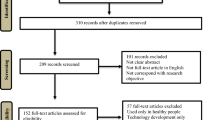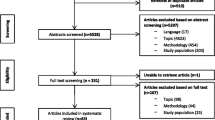Abstract
Background: Vocational rehabilitation (VR) is aimed at engaging or re-engaging individuals with work participation and employment. The International Classification of Functioning, Disability and Health (ICF) by the World Health Organization can be operationalized in the context of VR. The objective of this study is to review the literature to identify outcomes or measures being used in VR using a systematic review methodology and link those measures to the ICF. Methods: We applied a structured search strategy using multiple databases. Items or constructs of the measures or outcomes identified were linked to the ICF by two trained individuals. Results: We have identified 648 measures which contained 10,582 concepts that were linked to the ICF which resulted in 87 second-level ICF categories. Out of the 87 categories, 31 (35.6%) were related to body functions, 43 (49.4%) were related to activities and participation, and 13 (14.9%) were related to environmental factors. No category was related to body structures. Conclusions: Our review found great diversity in the ICF contents of the measures used in different VR settings and study populations, which indicates the complexity of VR. This systematic review has provided a list of ICF categories which could be considered towards a successful VR.

Similar content being viewed by others
References
Khan F, Ng L, Turner-Stokes L. Effectiveness of vocational rehabilitation intervention on the return to work and employment of persons with multiple sclerosis. Cochrane Database Syst Rev. 2009;1(1):CD007256.
Lysaker PH, Davis LW, Bryson GJ, Bell MD. Effects of cognitive behavioral therapy on work outcomes in vocational rehabilitation for participants with schizophrenia spectrum disorders. Schizophr Res. 2009;107(2–3):186–91.
Suoyrjo H, Oksanen T, Hinkka K, Kivimaki M, Klaukka T, Pentti J, et al. The effectiveness of vocationally oriented multidisciplinary intervention on sickness absence and early retirement among employees at risk: an observational study. Occup Environ Med. 2009;66(4):235–42.
Marini I, Lee GK, Chan F, Chapin MH, Romero MG. Vocational rehabilitation service patterns related to successful competitive employment outcomes of persons with spinal cord injury. J Vocat Rehabil. 2008;28(1):1–13.
Dutta A, Gervey R, Chan F, Chou CC, Ditchman N. Vocational rehabilitation services and employment outcomes for people with disabilities: a United States study. J Occup Rehabil. 2008;18(4):326–34.
Crowther R, Marshall M, Bond G, Huxley P. Vocational rehabilitation for people with severe mental illness. Cochrane Database Syst Rev. 2001;2(2):CD003080.
World Health Organization. International classification of functioning, disability and health. 2001; WHO, Geneva.
Young AE. Return to work following disabling occupational injury—facilitators of employment continuation. Scand J Work Environ Health. 2010;36(6):473–83.
Lagerveld SE, Bultmann U, Franche RL, van Dijk FJ, Vlasveld MC, van der Feltz-Cornelis CM, et al. Factors associated with work participation and work functioning in depressed workers: a systematic review. J Occup Rehabil. 2010;20(3):275–92.
Homa DB. Using the international classification of functioning, disability and health (ICF) in job placement. Work. 2007;29(4):277–86.
Gehanno JF, Rollin L, Le Jean T, Louvel A, Darmoni S, Shaw W. Precision and recall of search strategies for identifying studies on return-to-work in Medline. J Occup Rehabil. 2009;19(3):223–30.
Marshall M, Bond GR, Huxley P. Vocational rehabilitation for people with severe mental illness. Cochrane Database of Systematic Reviews 2001(2. Art. No.: CD003080).
Ware JE Jr., Sherbourne CD. The MOS 36-item short-form health survey (SF-36). I. Conceptual framework and item selection. Med Care. 1992;30(6):473–83.
Cieza A, Geyh S, Chatterji S, Kostanjsek N, Ustun B, Stucki G. ICF linking rules: an update based on lessons learned. J Rehabil Med. 2005;37(4):212–8.
Cohen J. A coefficient of agreement for nominal scales. Educ Psychol Meas. 1960;20:37–46.
Efron B. The jack nife, the bootstrap and other resampling plans. Philadelphia, PA: Society for industrial and applied mathematics; 1982.
Vierkant RA. A SAS macro for calculating bootstrapped confidence intervals about a Kappa coefficient. Available from: http://www2.sas.com/proceedings/sugi22/STATS/PAPER295.PDF.2009.
Stevens KR. Systematic reviews: the heart of evidence-based practice. AACN Clin Issues. 2001;12(4):529–38.
Mulrow CD. Rationale for systematic reviews. BMJ. 1994;309(6954):597–9.
Stubbs J, Deaner G. When considering vocational rehabilitation: describing and comparing the Swedish and American systems and professions. Work. 2005;24(3):239–49.
Muijzer A, Groothoff JW, de Boer WE, Geertzen JH, Brouwer S. The assessment of efforts to return to work in the European Union. Eur J Public Health. 2010.
Lee R, Chan C. Factors affecting vocational outcomes of people with chronic illness participating in a supported competitive open employment program in Hong Kong. Work. 2005;25(4):359–68.
Buijs PC, Lambeek LC, Koppenrade V, Hooftman WE, Anema JR. Can workers with chronic back pain shift from pain elimination to function restore at work? Qualitative evaluation of an innovative work related multidisciplinary programme. J Back Musculoskelet Rehabil. 2009;22(2):65–73.
Dekkers-Sanchez PM, Wind H, Sluiter JK, Frings-Dresen MH. A qualitative study of perpetuating factors for long term sick leave and promoting factors for return to work: chronic work disabled patients in their own words. J Rehabil Med. 2010;42(6):544–52.
Patten SB, Williams JV, Wang J. Mental disorders in a population sample with musculoskeletal disorders. BMC Musculoskelet Disord. 2006;7:37.
Wang J, Adair CE, Patten SB. Mental health and related disability among workers: a population-based study. Am J Ind Med. 2006;49(7):514–22.
United States Joint and Bone Decade: The Burden of Musculoskeletal Diseases in the United States. Available from: http://www.boneandjointburden.org.2008/.
World Health Organization. The burden of musculoskeletal conditions at the start of the new millenium. 2003;WHO Technical Report Series 919.
Beck A, Steer R, Brown G. Manual for Beck Depression Inventory-II. 1996.
Overall JEG. D.R. Psychiatric Rating Scale (BPRS): recent developments in ascertainment and scaling. Psychopharmacol Bull. 1988;24:97–9.
Study protocol for the World Health Organization project to develop a Quality of Life assessment instrument (WHOQOL). Qual Life Res. 1993;2(2):153–9.
Kori SH, Miller RP, Todd DD. Kinesiophobia: a new view of chronic pain behaviour. Pain Manage. 1990;3:35–43.
Chibnall JT, Tait RC. The Pain Disability Index: factor structure and normative data. Arch Phys Med Rehabil. 1994;75(10):1082–6.
Melzack R. The McGill Pain Questionnaire: major properties and scoring methods. Pain. 1975;1:277–99.
Michael JL, Sullivan SR, Bishop JP. The pain catastrophizing scale: development and validation. Psychol Assess. 1995;7(4):524–32.
Roland MO, Morris RW. A study of the natural history of back pain. Part 1: Development of a reliable and sensitive measure of disability in low back pain. Spine. 1983;(8):141–4.
Waddell G, Newton M, Henderson I, Somerville D, Main CJ. A Fear-Avoidance Beliefs Questionnaire (FABQ) and the role of fear-avoidance beliefs in chronic low back pain and disability. Pain. 1993;52(2):157–68.
Fairbank JC, Couper J, Davies JB, O’Brien JP. The Oswestry low back pain disability questionnaire. Physiotherapy. 1980;66(8):271–3.
Drews B, Nielsen CV, Rasmussen MS, Hjort J, Bonde JP. Improving motivation and goal setting for return to work in a population on sick leave: a controlled study. Scand J Public Health. 2007;35(1):86–94.
Sang LS, Ying Eria LP. Outcome evaluation of work hardening program for manual workers with work-related back injury. Work. 2005;25(4):297–305.
Schonherr MC, Groothoff JW, Mulder GA, Schoppen T, Eisma WH. Vocational reintegration following spinal cord injury: expectations, participation and interventions. Spinal Cord. 2004;42(3):177–84.
Sanderson K, Nicholson J, Graves N, Tilse E, Oldenburg B. Mental health in the workplace: using the ICF to model the prospective associations between symptoms, activities, participation and environmental factors. Disabil Rehabil. 2008;30(17):1289–97.
Sandqvist JL, Henriksson CM. Work functioning: a conceptual framework. Work. 2004;23(2):147–57.
Luk KD, Wan TW, Wong YW, Cheung KM, Chan KY, Cheng AC, et al. A multidisciplinary rehabilitation programme for patients with chronic low back pain: a prospective study. J Orthop Surg. 2010;18(2):131–8.
Bultmann U, Sherson D, Olsen J, Hansen CL, Lund T, Kilsgaard J. Coordinated and tailored work rehabilitation: a randomized controlled trial with economic evaluation undertaken with workers on sick leave due to musculoskeletal disorders. J Occup Rehabil. 2009;19(1):81–93.
Brouwer S, Reneman MF, Bultmann U, van der Klink JJ, Groothoff JW. A prospective study of return to work across health conditions: perceived work attitude, self-efficacy and perceived social support. J Occup Rehabil. 2010;20(1):104–12.
Kirsh B, Krupa T, Cockburn L, Gewurtz R. A Canadian model of work integration for persons with mental illnesses. Disabil Rehabil. 2010.
Sackett DL, Rosenberg WM, Gray JA, Haynes RB, Richardson WS. Evidence based medicine: what it is and what it isn’t. Clin Orthop Relat Res. 2007;455:3–5.
Kay SR, Fiszbein A, Opler LA. The positive and negative syndrome scale (PANSS) for schizophrenia. Schizophr Bull. 1987;13(2):261–76.
Zigmond AS, Snaith RP. The hospital anxiety and depression scale. Acta Psychiatr Scand. 1983;67(6):361–70.
Berg EA. A simple objective technique for measuring flexibility in thinking. J Gen Psychol. 1948;(39):15–22.
Reitan RM. Validity of the trail making test as an indicator of organic brain damage. Percept Mot Skills. 1958;8:271–6.
Gorham DR. Use of the proverbs test for differentiating schizophrenics from normals. J Consult Psychol. 1956;20(6):435–40.
American Psychiatric Association, editor. Diagnostic and statistical manual of mental disorders (4th ed., text rev.);2000.
Acknowledgments
The authors would like to thank Dr. Teresa Brinkel, Anne-Katrin Brust, Kathrin Ecker, and Wolfgang Segerer for providing technical consultation and help during the conduct of the study. Special thanks to Cristina Bostan, who is supported by a Marie Curie Fellowship from the EU funded project MURINET, the ICF Research Branch and the Swiss Paraplegic Research in Nottwil, Switzerland. This project was funded by the Swiss Accident Insurance Company (SUVA).
Conflict of interest
None.
Author information
Authors and Affiliations
Corresponding author
Rights and permissions
About this article
Cite this article
Escorpizo, R., Finger, M.E., Glässel, A. et al. A Systematic Review of Functioning in Vocational Rehabilitation Using the International Classification of Functioning, Disability and Health. J Occup Rehabil 21, 134–146 (2011). https://doi.org/10.1007/s10926-011-9290-8
Published:
Issue Date:
DOI: https://doi.org/10.1007/s10926-011-9290-8




